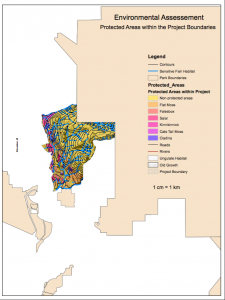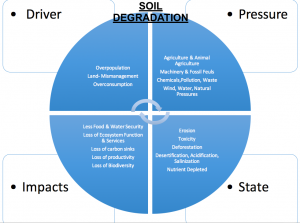Soil Degradation; Overlooked, Oversimplified, and Overworked
In current discussions surrounding climate change and environmental crises, many issues are considered wicked problems. These problems are defined as wicked because there is no single, predictable solution and we must balance between the economic, environmental and social interests of multiple stakeholders (Bouma, 2013). One of the most often overlooked wicked problems of the 21st century is soil degradation even though it is vital to so many different earth systems and ecosystem functions. Soil degradation involves both the natural and anthropogenic pressures put on soils leading to physical, chemical, biological and ecological soil degradation. Soils are considered non-renewable resources, and can take thousands of years to build back up to fertile, productive states (Osman, 2014). Soil degradation is not overlooked due to a lack of data, on the contrary “many studies convincingly document the importance of soils when dealing with the global environmental sustainability issues of today…. [however,] recent strategic environmental reports hardly mention soils” (Bouma, 130). The current state of our soils, and in turn most of our livelihoods, depends on soil degradation becoming a global issue that is should be.
The degradation of the planet’s soils is far from recent due to anthropogenic and natural pressures that have been affecting the surface of the planet since its creation. Harsh winds, flash flooding, topology, glaciation, acidification, salinization are all examples of natural soil degradation. Humans have been using the land for centuries and have degraded soils through land-use mismanagement, compacting soils, nutrient depletion, disposal of waste, chemical contamination and irrigation methods (Forge, 1998). All these factors put pressure on, and effect the fertility, productivity, health, and quality of our soils (Osman, 2014).
The authors of Breaking the Sod argue that there have been three major waves of erosion from anthropogenic pressures in our relatively short history on earth. The first wave of erosion came with our first civilizations and their experiments with agriculture. A modest amount of erosion from these civilizations happened as they learned how to balance irrigation, nutrient replacement, and crop rotation. Some early civilizations were not successful in finding harmony with the land, and soil degradation led to famine or, in extreme cases, the collapse of civilizations. The second wave of significant anthropogenic erosion came as humans manufactured and used stronger and sharper agricultural tools. These instruments helped them to break up the soil and leave it more vulnerable to natural processes of erosion such as wind and water runoff. Later on this led to the compaction of soils through livestock and heavy machinery. The third wave of erosion comes with the rapid population growth, modern medicine to extend our lifespans, and our migration from farms to cities in the 20th century. Urban cities are directly responsible for “nutrients from fields [leaving] to cities” (McNeill, 1627) and disrupting the delicate balance. This results in more degradation as farmers have no choice but to use fertilizers to put nutrients back into the soils. The rate of erosion following these three waves has grown exponentially, and the “past 60 years have brought human-induced soil erosion and the destruction of soil ecosystems to unprecedented levels” (McNeill, 1628).
In the Canadian context, we are a nation that relies economically on resource exploitation, which has led to direct negative impacts on our soils. In the 1920’s Alberta alone saw 10 000 abandoned farms which was followed by prolonged drought and depression in the 30’s. This era was called the “Dust Bowl”, where our fertile soils turned to dust, which led to the Prairie Farm Rehabilitation administration. In the 1980s the prairies saw another period of drought which led to severe erosion and salinity of the landscape. In a 1983 report it was estimated that the cost to society from salinity was $257 million/year and the cost from wind and water erosion was $368 million/year. From this desperate situation a number of recommendations were made that included direct seeding, decreased tillage, planting foraging crops on marginal lands, wind breaks, grassed waterways, strip cropping and perennial barriers (Forge, 1998).
The quality of soil can be found using a variety of methods, and can differ depending on the type of soil you are trying to measure. However, the most reliable indicator is soil organic carbon. Soil organic carbon includes the living soil biota and the dead biotic material found in the soil, predominantly in the topsoil (Lal, 2015). Other methods include electrical conductivity, available soil water, micro-aggregates, and dehydrogenase activity, respectively (Rajan, 2010).
Data and the use of soil organic carbon is also an important factor in the global carbon budget, something that is largely disregarded. Lal argues that “carbon (C) dynamics and emission of carbon dioxide (CO2 ) and other other greenhouse gases (GHG’s) into the atmosphere have not been given the emphasis they deserve” (Lal, 438) in climate change discussions. In addition to an already wicked problem, “emission of CO2 and other GHGs by soil degradation is an important but neither an obvious nor an easily quantifiable source” (Lal, 340). Although it is hard to fit soil degradation into the budget, it cannot be disregarded as it currently has been. The terrestrial carbon pool, which includes the planet’s soil and vegetation, is the third largest pool in the carbon budget. Within this, the soil carbon pool, to one meter in depth, accounts for 2300 Pg alone, which is three times that of the atmospheric pool. Furthermore, is it estimated that soils release 4% of their carbon pools annually into the atmosphere, contributing to climate change, which is ten times that of fossil fuel combustion (Lal, 2002). Soil degradation needs to be included in climate discussions and projects to ensure that we are keeping track of all our carbon sources and sinks.
Although soil degradation can easily be described using the soil organic carbon, the data on soil degradation remains limited for several reasons. First, soil types differ substantially around the world, and it is hard to make meaningful comparisons. Second, natural and anthropogenic processes of erosion are not distributed equally, making it hard to compare across large areas. Third, there are many factors within the composition of soil that are either underestimated or overestimated, leading to different outcomes and predictions. This is most apparent in the estimates of historic loss in the soil organic carbon due to land use change, where “the global loss has been estimated at 40Pg, … 55pg, … 65-90Pg, … 150Pg, … 500Pg, … and 537Pg” (Lal, 440). This is a huge range within the estimates, and makes using the data very difficult. Finally, the most important factor limiting the effects of soil degradation to larger climate threads is that “exploratory simulation models… either ignore the soil or assume the presence of some “standard soils” everywhere” (Bouma, 130). The simplification of soil in computer run models is extensive and in return, often forgotten in climate discussions. This should be a large concern in the coming years to put soil into climate conversations and models.
As previously mentioned, soil degradation is not new, nor is it uniquely anthropogenic, so why should it matter this much? The state of our soils should be as important to us as water availability, because it is vital to our survival. Soils play a direct role in our food security, water security, nutrient cycling, waste cycling and carbon cycling. Our planet seems huge, but in reality, roughly 12% of our land is well suited for the production of food and fibre, 24% is grazing land, and the remaining 31% is forest land (Osman, 2014). Furthermore, it is estimated that “2 billion ha of land that was once biologically productive has been irreversibly degraded since 100 AD” (Lal, 438). In the last 60 years there has been a decrease in ecosystem services by 60% (Lal, 2015). These disastrous affects are not subsiding and directly impact every single person on this planet. In July 2009, our population was 6.79 billion people and our arable land was 1.351 billion ha, which yields 0.20ha of cropland per capita. The threshold to sustain human populations is more than twice that, sitting at 0.5ha/capita (Osman, 2014). At the end of 2016, we now sit at 7.46 billion, which brings that ratio to 0.181ha/capita. The state of our soils need to be carefully considered as we move through conversations of sustainability.
Without a doubt, humans are the main drivers of soil degradation because it is our primary source of acquiring sustenance. Unfortunately, we represent multiple drivers resulting in the pressures felt by the soil. First is our overall population, that is continuing to grow. This not only means more mouths to feed, but there is also more pressure to accommodate all these people, which includes housing, waste management, and resources like timber, brick and infrastructure. A second major anthropogenic driver is our habits of overconsumption. Obesity is considered a global epidemic, and can be attributed to the amount of processed, sugary, salty, and animal based products that we are consuming. As developing countries gain economic wealth, they are choosing the “North American Diet” as well and obesity is spreading across the world. Not only does the average American diet include health risks and increased greenhouse gas emissions, it also affects land availability. Animal agriculture contributes to 30% of the Earth’s landmass for grazing land and land dedicated to growing animal feed. In the United States alone this number is 80% of agricultural land dedicated to animal agriculture (Facts on Animal Farming and the Environment). Overconsumption does not just include the food we consume, but also extends to material goods that are later discarded into the environments polluting our soils. The third anthropogenic driver to highlight is land management, or lack there of. It was Canada’s experience that “the health of soils will continue to deteriorate in areas where intensive agriculture is practised and on low-productivity lands where ecological agricultural methods are not being used” (Forge, 3). Canada was fortunate enough to have the economic backing to reverse the trend of soil degradation however, this is not always the case, “when people are poor, desperate and hungry, they pass on their sufferings to the land” (Lal, 5888).
In response to being overworked, the soils of the world are giving into the pressures of mismanagement and pollution in four major forms of degradation. Our soils are degrading physically from compaction, crusting, reduced infiltration and changing pore geometry. These can be attributed to heavy machinery, agricultural tools, livestock, and temperature changes associated with climate change. Chemical degradation can result in acidification, salinization, nutrient depletion, toxicity, and reduced exchanging capabilities. These types of degradation can come from natural and anthropogenic factors such as slash and burn farming, fertilizers, pesticides, herbicides, fungicides, and processes of leaching. Biological degradation that is affecting our soils can lead to carbon depletion, loss of biodiversity, and increased greenhouse gas emissions. This type of degradation happens predominantly from agricultural mismanagement regimes. Finally, ecological degradation pertains to the disruption of ecosystem functions or services, including reduced productivity and reduced element cycling (Lal, 2015). With our growing need for the soils to produce exponentially, we often turn to “the use of large amounts of fertilizers, pesticides and irrigation to help offset deleterious effects of erosion, but [these] have the potential to create pollution and health problems, destroy natural habitats, and contribute to high energy consumption and unsustainable agricultural systems (Pimental, 1117).
Soil degradation should be considered a wicked problem and taken more seriously because it is leading to larger issues such as deforestation, greenhouse gas emissions, nutrient depletion in our food, erosion, bioaccumulation of toxins, food security and water security. These can all be linked to soil degradation however, it will take a lot of change on the part of many corporations, industries and individuals. Our soils are being filled with chemical pesticides, fertilizers and other sprays which are bringing in millions of dollars annually. This also contributes to fossil fuel consumption. Furthermore, the majority of our crop land is being used to raise animal feed, and there are a lot of Americans who would strongly oppose cutting out large portions of their meat and dairy consumption. There is also the problem of the general public and industry dumping waste that pollutes our soils. In addition, with the majority of our society living in cities, it is hard to instil how important a harmonized relationship with the soil really is, because less and less people are exposed to it. There are so many complexities with our relationship to the soil that makes degradation truly a wicked problem, and one that needs addressing immediately.
The astonishing rates of soil erosion of between 40 and 17 tons ha-1/year-1 lead to global associated costs of $400 billion dollars a year (Pimentel, 1121). The United States has some of the lowest rates of soil erosion, at 17 tons ha-1/year-1, and even so has seen 30% of farmland abandoned due to erosion, salinization and waterlogging (Pimentel, 1117). Soil degradation is expensive and vital to our survival, and has the potential to lead to political and domestic conflicts. Although anthropogenic forces are largely to main drivers of these pressures, conservation and soil stewardship can have lasting impacts, as seen in Canada and elsewhere in the world. Conservation and erosion control techniques are “reliable and proven… [and] include ridge-planting, no-till cultivation, crop rotations, strip cropping, grass strips, mulches, living mulches, agroforestry, terracing, contour planting, cover crops and wind breaks” (Pimentel, 1121). Furthermore, consumers and municipalities have the ability to help soil degradation through composting and waste management techniques, banning of chemicals used in agriculture and elsewhere, sustainable food choices, and raising awareness to important issues pertaining to sustainability. In the 21st century, knowledge is power, and we all have the responsibility to be educated on the issues that matter for our next generation.
References:
Bouma, J., & Mcbratney, A. (2013, March 22). Framing Soils as an Actor When Dealing With Wicked Environmental Problems. Geoderma, 200-201, 130-139.doi:10.1016/j.geoderma.2013.02.011
Facts on Animal Farming and the Environment. (n.d.). Retrieved fromhttp://www.onegreenplanet.org/animalsandnature/facts-on-animal-farming-and-the-environment/
Forge, F. (1998, August 27). Agriculture Soil Conservation in Canada (MR151e). Retrieved from http://publications.gc.ca/Collection-R/LoPBdP/MR/mr151-e.htm
Lal, R. (2002, November 29). Soil Erosion and the Global Carbon Budget. Environment International, 29(437), 450th ser., 437-450. doi:10.1016/s0160-4120(02)00192-7
Lal, R. (2015, May 13). Restoring Soil Quality to Mitigate Soil Degradation. Sustainability, 7(5), 5875-5895. doi:10.3390/su7055875
Mcneill, J. R., & Winiwarter, V. (2004, June 11). Breaking the Sod: Humankind, History, and Soil. Science Magazine, 304(5677), 1627-1629. doi:10.1126/science.1099893
Osman, K. T. (2014). Soil Degradation, Conservation and Remediation. Dordrecht: Springer.
Pimentel, D., Harvey, C., Resosudarmo, P., Sinclair, K., Kurz, D., Mcnair, M., . . . Blair, R. (1995, February 24). Environmental and Economic Costs of Soil Erosion and Conservation Benefits. Science, 267(5201), 1117-1123. doi:10.1126/science.267.5201.1117
Rajan, K., Natarajan, A., Anil Kumar, K., Badrinath, M., & Gowda, R. (2010, September 25). Organic Soil Carbon – The Most Reliable Indicator for Monitoring Land Degradation by Soil Erosion. Current Science, 99(6), 823-827. Retrieved from http://environmentportal.in/files/Soil organic carbon.pdf



